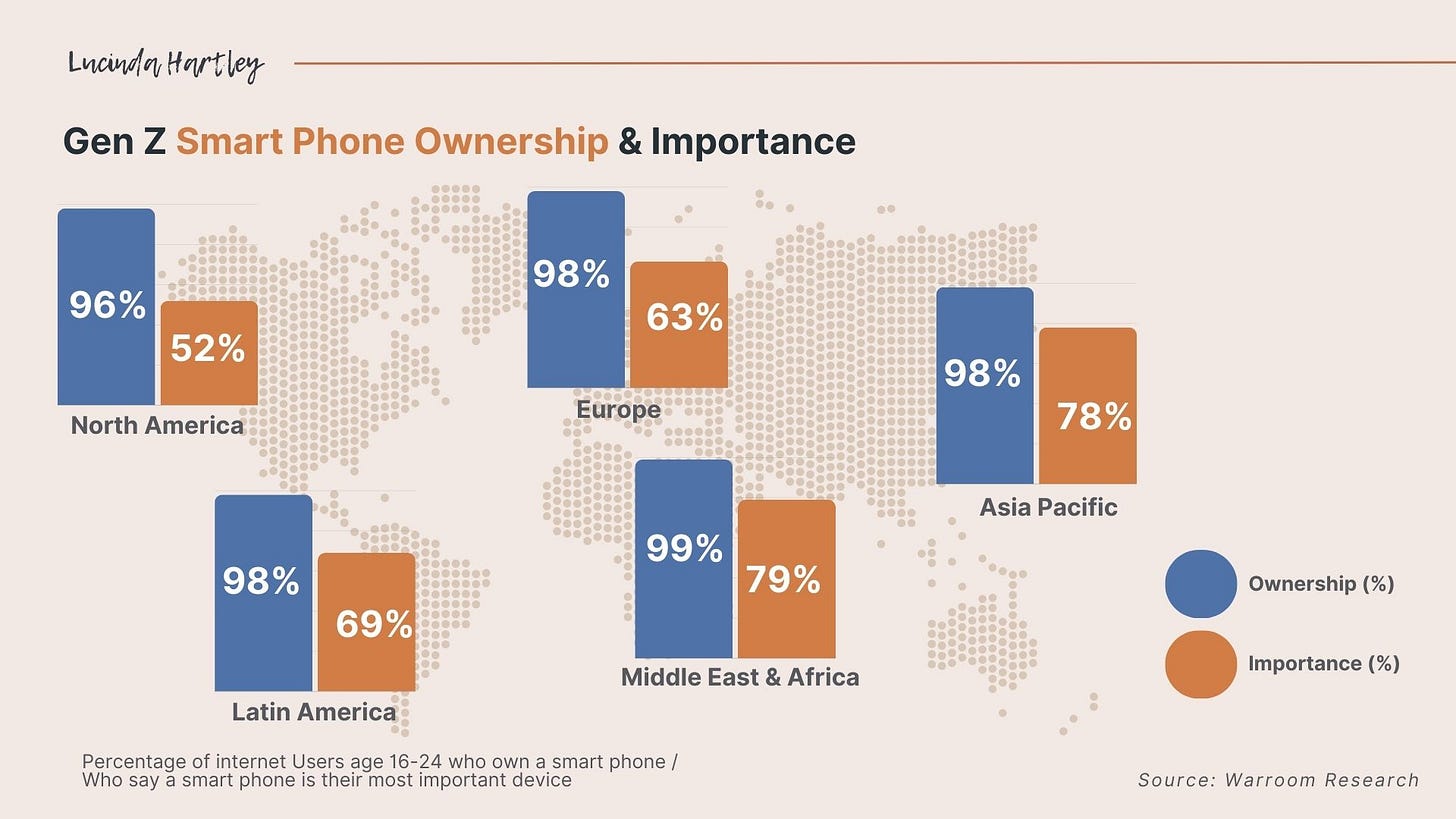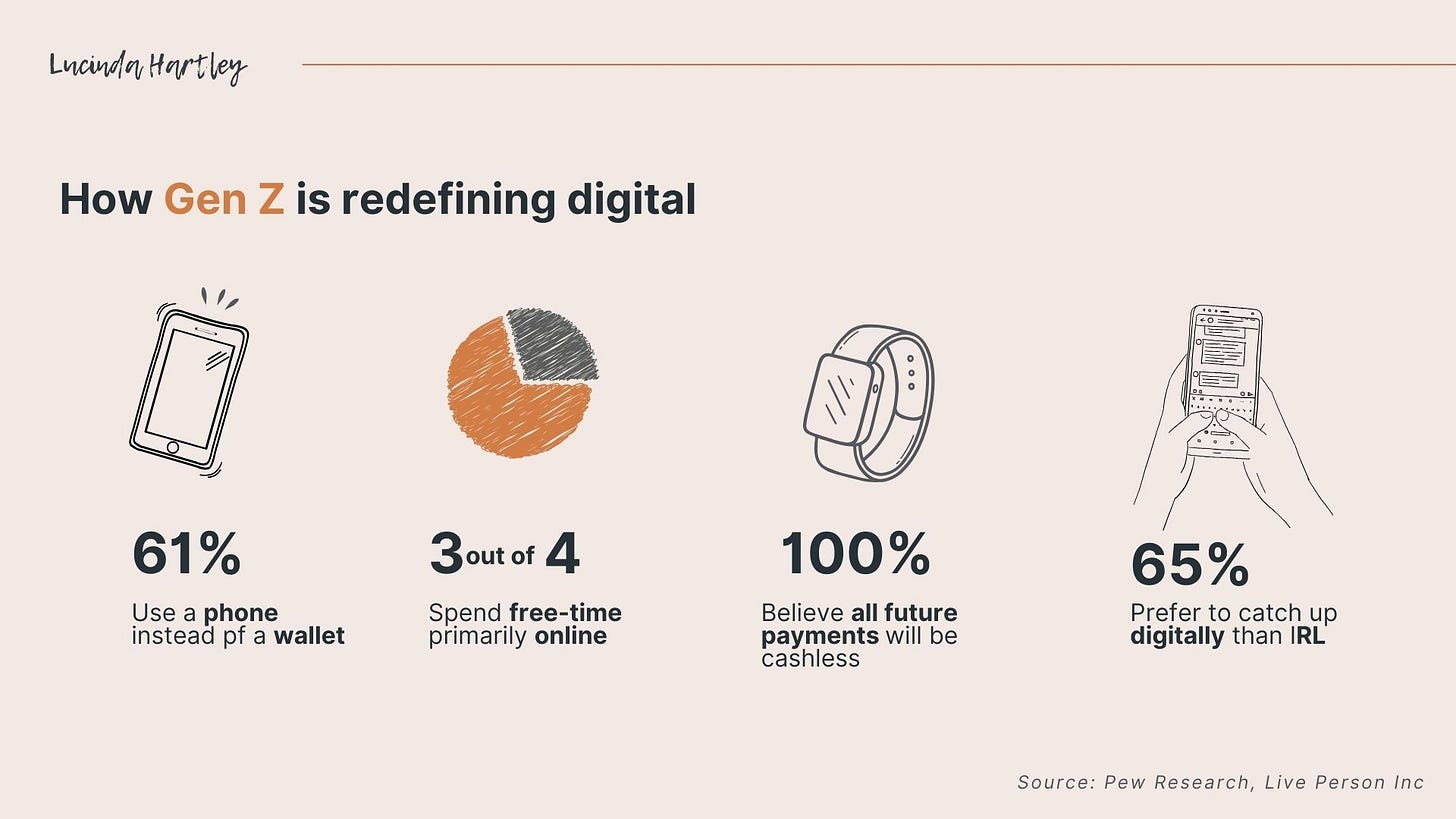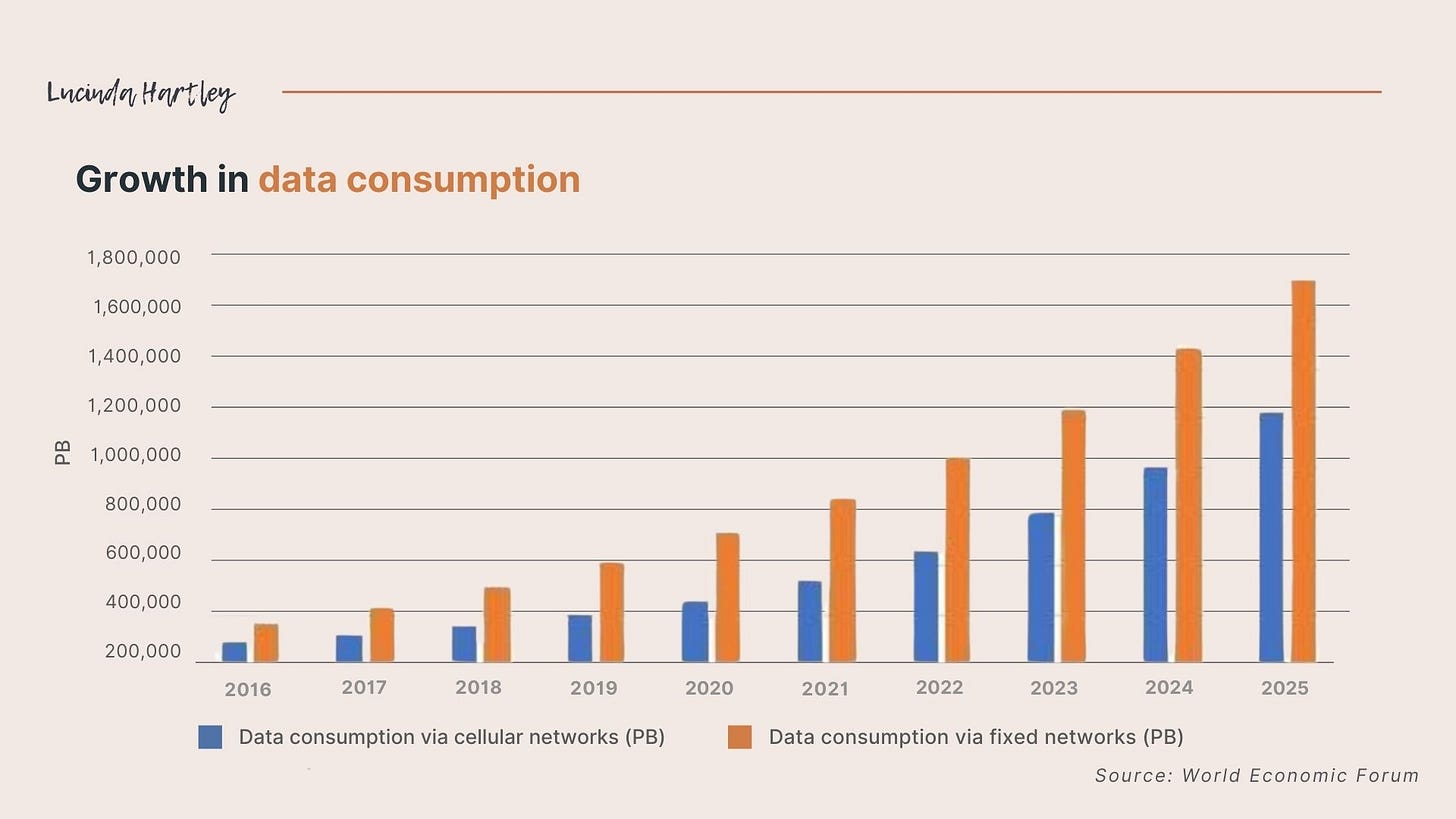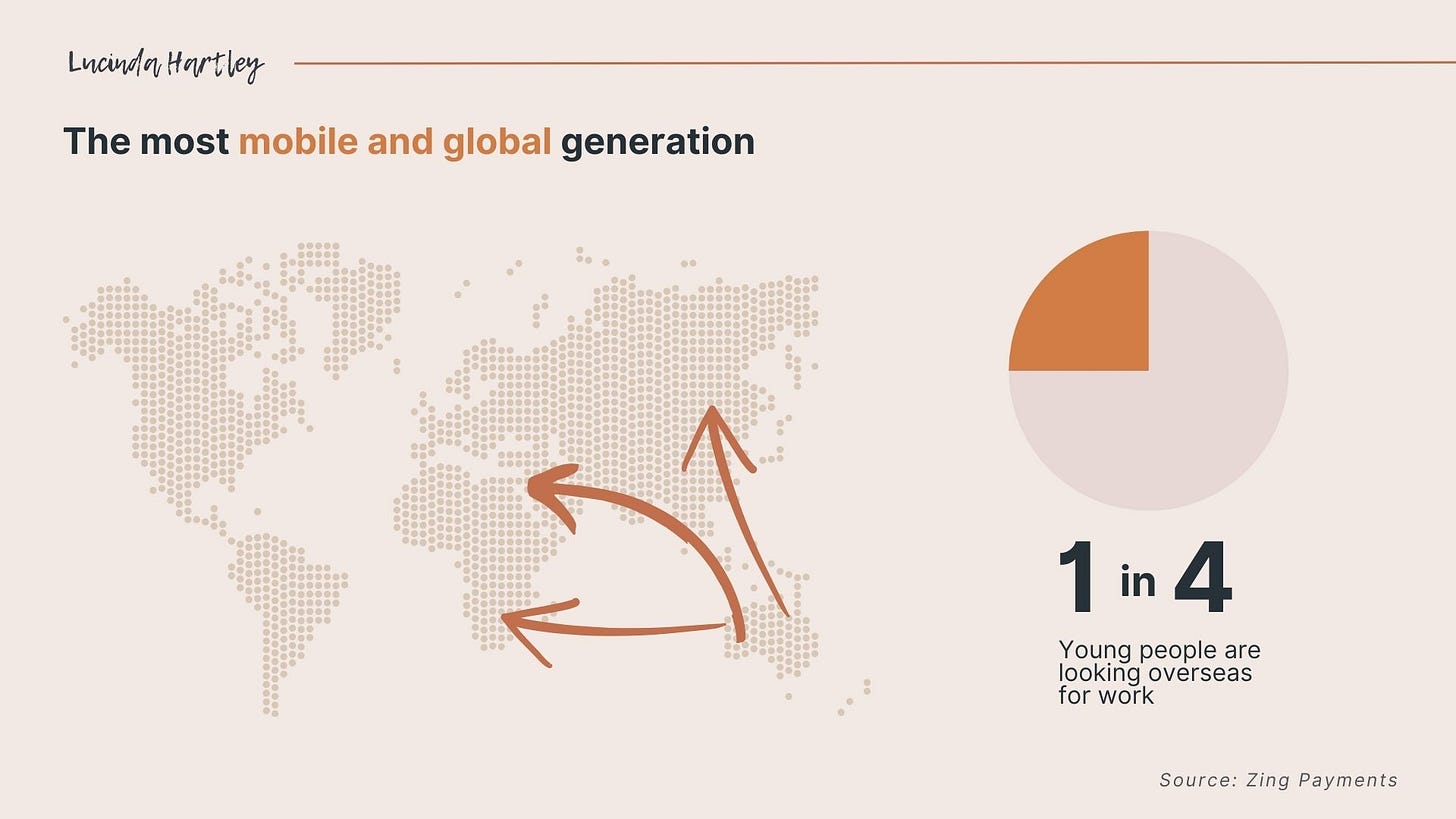Who is the future citizen? Three shaping forces defining a generation
The majority of Gen Z can imagine a future where most of life is digital, but are our cities, housing and infrastructure keeping up?
I’m Lucinda 👋, an award winning technology founder, urban futurist and keynote speaker. Welcome to Urban Happiness 🙂, where I share weekly bite-sized updates on the latest social trends and urban issues, to help leaders make informed decisions about the future.
When did you last carry a wallet?
The only time I carry my wallet these days is when I need to use public transport, so I can cycle through one of my four train passes hoping one of them is still active (I’m not an android user, so I still need a separate Myki card on Melbourne’s transport system). Almost all of the other things I need to do - access credit cards, tickets, boarding passes, even ID - is online and on my phone. In many cities, I don’t even need the public transport ticket, that’s on my phone too.
The phone is the new wallet, and it’s just one example of the digitisation of our lives.
If there is one undeniable force shaping the identity of the future citizen, it’s the digital era. Generation Z are “Extremely online”, averaging 7.3 hours a day online. This means is that the primary orientation of life for many is now digital. This profoundly reshaping future lifestyle, work habits, and even next generation of the internet.
But this is mixed with a shifting financial landscape, cost of living pressures and growing climate anxiety. The needs, values and lifestyle patterns of future citizens are shifting.
Our decision making needs to shift too.
Shaping forces
There are three key lifestyle factors influencing the future citizens, beyond demographic shifts which I explored in the last post. Keep reading below 👇🏼.
In this series I’m covering the TL;DR summary of trends about the future citizen so that industry professionals can make informed decisions about the future.
Check out Part 1, Generation Influence, here, or subscribe for the upcoming series covering:
Shaping Forces
How will they work?
How will they live?
How will they dwell?
1. Digital & Hyper-Connected
Gen Z is redefining digital. 98% of Gen Z own a smart phone, and the majority feel its their most important device - particularly in Africa and Asia. However it’s less about the smartphone and more about how this reorients our lifestyle and how we connect. Its the merging of our digital and physical worlds.
Digital Lifestyle
With regards to digital lifestyle:
Free time, online: 3 out of 4 Gen Z-ers say the primary activity in their free time is spent online
Digital information seekers: Gen-Z are most likely to turn to the internet for news, retail, medical information. They are also most likely to get news from Reddit, Tik Tok, Instagram, with a smaller percentage from youtube (that is, unless Meta’s rules change).
The phone is the new wallet: 61.8% of Gen Z would choose to tap their phone, and leave their wallet behind.
The future is 100% digital payments: A majority of Gen Z and Millennials (69.5%) can imagine a future where 100% of purchases are done digitally/online. In some places like Kenya, payments are already mostly cashless.
Digital is the new IRL
With regards to social connection, research shows that Gen Z does not distinguish between online and offline experiences in the same way previous generations who didn’t grow up digital do, and see social media as an extension of our lives. Globally, 65% Gen Z and Millennials communicate with others more digitally, than IRL (“In Real Life”).
Demand for data
As our lives move online there is an increasing merging of physical or digital worlds - coined “phygital” spaces. Whether its scanning a QR code to gain information or order food, tracking your run on GPS or installing smart sensors in public spaces to control lights.
The result of this increased activity is a demand for data. Global data consumption grew more than 30% last year, according to the World Economic Forum. Unsurprisingly, Its Gen Z that produces the largest volume of online data / searches according to google data trends.
For decision makers
For cities and infrastructure, this means getting ahead of the curve with digital infrastructure. Meeting demand for distributed data networks and fibre internet needs to be a fundamental consideration for urban planning, and that our work and living patterns are enabled to be more nomadic and distributed. Too often, it’s an afterthought.
2. Global and Mobile
Gen Z have been named the “first global generation,” growing up in a society where global content and information available on demand.
Buying power
Online shopping is the norm, with a rise in e-commerce and on-demand delivery, which in turn unlocks new markets beyond traditional markets, many of which are overseas.
Gen Z makes up more than 40% of all U.S. consumers. This makes their collective buying power around $143 Billion. This enormous level of consumer power is changing the way entire markets and buying patterns work - with brands increasingly engaging online only, digitally, visually and with a global-first audience.
Work form anywhere
The rise of flexible and remote work, accelerated by Covid-19 lockdowns affects most industries. It’s Gen Z, who entered the workforce at the time of the pandemic, that’s felt the impact of remote work the most. In future posts, we’ll talk more about work impacts of the future citizen. The point to note here is that if work can be anywhere - home can be anywhere too.
One in Four Gen Z-ers plans to move overseas, according to research by the payments app Zing. In some places like Singapore it’s even higher where half of young people plan to look abroad for work. Interestingly, it’s not about moving for a physical job, often it’s driven by expat lifestyles and remote work, chasing cheaper living conditions and new experiences.
For decision makers
From a cities perspective, we can expect changes in settlement patterns with more people working remote, and moving around, with greater likelihood of people working across borders.
We also need high levels of agility to allow for companies and neighbourhoods where people will move around, and work remotely.
3. Ethical and Values Driven
Gen Z is a self-reliant and purpose-driven generation, used to being able to learn and solve their own problems (thanks to the internet).
More than money
Gen Z want more than money from their jobs than money. A recent ING study has shown that 46% want a sense of purpose from work and that values alignment was the second highest factor (after salary) in choosing an employer.
Conscious consumers:
Gen Z are leading sustainable retail, increasingly making purchasing choices driven by the impact these choices make in the world.
A recent report reveals that 62% of Gen Z shoppers prefer to buy from sustainable brands, and a staggering 73% are willing to pay more for sustainable products.
For decision makers:
For business leaders this means increasingly that values alignment is a critical part of talent attraction and active and meaningful consideration of ESG at the top level.
🙋🏽♀️ How is your organisation engaging with future citizens?
Let us know in the comments below.
👉 Subscribe for more ideas
Get regular updates on the latest social trends.







